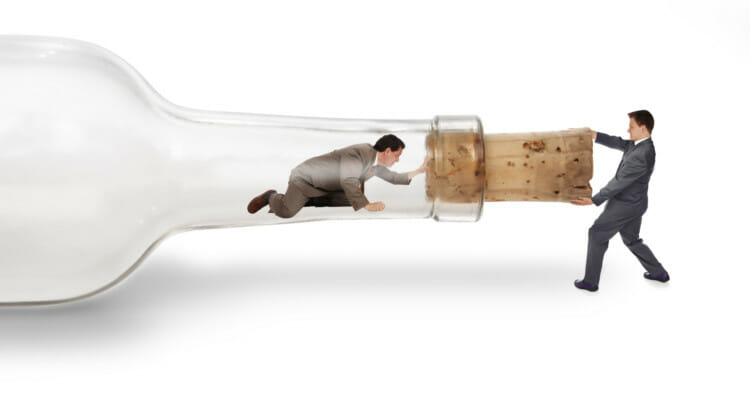If you're the "Human API" that everything flows through, you're not scaling—you're becoming the constraint that limits your company's growth capacity.
Around 70% of startups fail at the scaling stage¹, not because their products don't work or markets don't exist, but because they hit an invisible ceiling. The leadership approach that got them to their first million becomes the bottleneck that prevents them from reaching ten million.
The 30% who break through aren't just lucky. They recognize and systematically avoid three predictable traps that catch most founders and CEOs off-guard. These aren't random obstacles—they're patterns that emerge as predictably as gravity when companies transition from startup agility to a more mature scale.
The Problem: When Success Becomes the Constraint
You're still involved in most of the selling because "no one knows the product like you do," not even your sales team. Every strategic decision flows through your desk because "the team needs direction." Your calendar is a nightmare of back-to-back meetings, each one punctuated by someone needing "just 5 minutes" of your time for a quick decision.
Research shows that 60% of founders remain heavily involved in their company's daily operations even years after the business is fully established². What started as necessary hands-on leadership has evolved into organizational dependency.
Companies that successfully navigate the $1M to $10M transition don't just add more processes or hire more people. They fundamentally transform how decisions get made and work gets done. Those that struggle often rely on the same strategies that got them to $1 million without realizing that what worked in the early days now holds them back in the next growth phase³.
According to the Theory of Constraints, a bottleneck determines what the overall throughput or production capacity of a system is⁴. If you as the founder or CEO are the bottleneck, you are literally limiting the capacity of your entire organization. The company can only produce outcomes at the rate that you can take action because most—if not all—final work flows past you in some way⁴.
There's a pattern to how leaders get stuck, and a clear path for how they break free.
The Founder Scaling Traps Framework

Trap 1: The Centralized Authority Bottleneck
Every decision, from major client deals to basic operational calls, needs your input. In other words, you want to maintain control. Your team has learned to bring everything to you "just to be safe," and you've inadvertently trained them that your approval is required for forward movement.
Two critical gaps create this trap. First, there's often unclear boundaries around what truly deserves leadership attention versus what can be handled at other levels. Second, and perhaps more importantly, there's a lack of clear structure and systems that empower others with genuine ownership and authority. When people don't have clear decision-making frameworks, they default to seeking approval from the top.
Leaders trapped here lose 5+ hours weekly to low-value interruptions. The hidden cost is higher: your team's capacity for independent thinking atrophies. They become order-takers or approval seekers rather than problem-solvers, which means you never actually build the leadership depth you need for sustainable scaling.
One founder realized that 78 of his 115 reports relied on him to make decisions that would unblock their work⁵. He wasn't just busy—he was the single point of failure for his entire organization's productivity.

Trap 2: The Analysis Paralysis Trap
Decisions get stuck in endless loops of data-gathering and committee discussions. Teams wait for direction that never comes with sufficient clarity. Good people get frustrated and leave because they can't get clear guidance on priorities.
Without shared criteria for what creates real value, every decision feels equally important and equally risky. Even when you have criteria, they're meaningless unless they're built on relationships of trust. People need to believe that the decision-making framework actually serves everyone's best interests, not just the leadership's preferences.
Organizational velocity slows to match the leader's decision-making speed. While competitors move quickly, your company gets bogged down in analysis. Market opportunities pass by while you're still in meetings about whether to pursue them.
A Series B company spent six months debating whether to enter a new market segment. By the time they decided to move forward, two competitors had already captured the early-mover advantage. The issue wasn't lack of data—it was lack of clear, trusted criteria for making strategic bets.
Trap 3: The Inconsistent Criteria Trap
What it looks like: Ad-hoc decisions that seem logical in the moment but contradict previous choices. Team confusion about what the actual priorities are. People hedge their bets by trying to do everything rather than focusing on what matters most.
There's no systematic approach to maintaining alignment while preserving the trust-based relationships that make rapid execution possible. Leaders often swing between micromanagement (which kills trust) and complete delegation (which creates chaos). The middle ground—systematic empowerment—requires intentional design.
You get growth without capacity building, which leads to inevitable breakdown. Revenue increases but profit margins shrink because inefficiency scales along with everything else. Eventually, the organization becomes too complex for the current leadership structure to manage, and something has to give.
This trap is particularly insidious because the symptoms look like success in the short term. Revenue grows, team size increases, and everything seems to be working—until it suddenly isn't.

How the 30% Break Through
The companies that successfully navigate these traps understand something fundamental: relationships built on trust are the foundation that enables everything else. Without this foundation, the best systems in the world become bureaucratic obstacles rather than empowering structures.
Strategic Throughline - Clarity About What Truly Matters
The breakthrough starts with leaders getting crystal clear about strategic outcomes that truly matter—not just for themselves, but for their customers and stakeholders. This isn't a planning exercise; it's a clarity exercise. The Strategic Throughline helps leaders identify what deserves their strategic attention versus what can be delegated or eliminated entirely.
One CEO described the transformation: "I went from having opinions about everything to having strong convictions about the few things that actually move the needles I’m accountable for. That clarity gave my team permission to own everything else."
Organizational Alignment - Speed Up Decisions With Shared Value-Creation Filters
With clearer strategic outcomes from the Strategic Throughline, decisions can be made faster at every level because everyone is working from the same value-creation filter. These filters are built on trust—people understand not just what to do, but why it matters and how their judgment is valued.
Teams can self-organize around shared understanding of what creates real value because they trust that the framework serves the collective good, not just executive preferences. This eliminates the analysis paralysis that comes from people second-guessing whether they're making the "right" decision.
Value-Aligned Systems - Build Infrastructure That Maintains Focus
The final step transforms strategic clarity into a “work to value system” that doesn't require constant oversight. These aren't rigid procedures that crush creativity—they're empowering structures that maintain alignment while giving people ownership over execution.
The magic happens when systems reinforce the trust-based relationships rather than replacing them. People follow the processes because they helped create them and they see how those processes serve their ability to do great work.
A Series B CEO shared: "We went from me being involved in every hiring decision to having a system where managers at every level can hire confidently because they understand our values and have clear frameworks for assessment. I still review the key hires, but now I'm reviewing great decisions rather than making all the decisions myself."
The Transformation: From Reactive to Strategic
When these three elements work together, the transformation is dramatic. Leaders reclaim strategic time not by working longer hours, but by eliminating the reactive patterns that waste time on things that don't actually matter. Teams operate autonomously within trusted relationships, making decisions that align with strategic outcomes without constant guidance.
The calendar shifts from back-to-back meetings about day-to-day operations to focused time on the strategic challenges that actually require leadership attention. The constant stream of "just 5 minutes" requests diminishes because people have clear frameworks for making decisions independently.
Growth starts building capacity rather than draining it. Each new person, process, and system adds to organizational capability rather than creating more complexity for leadership to manage.
You transform from being the Human API that everything flows through to being the strategic leader who creates the conditions for others to do their best work. Not by working harder, but by eliminating the reactive patterns while building the relational foundation that makes sustainable growth possible.
Experience This Transformation Firsthand
If you're ready to break free from the founder scaling traps and join the 30% who successfully navigate the leadership bottleneck, experience this approach through our Strategic Throughline intensive.
This comprehensive program has helped our clients reclaim 5+ hours of strategic time weekly while building the leadership infrastructure for sustainable scaling.
Book your Strategic Throughline consultation and discover how to transform from reactive firefighting to strategic leadership—without sacrificing the relationships that make it all worthwhile.
Sources
¹ "Scaling Challenges: A Founder's Guide to Staying Ahead" - The Recursive
² "Breaking the Bottleneck: Overcoming Founder Dependence for Sustainable Business Growth" - BestFit
³ "How to Scale a Business: Why $1M Founders Never Reach $10M" - Inc.com
⁴ "Are You a Bottleneck? How Founders Can Limit Their Company Growth" - Medium/The Startup
⁵ "Scaling up: How founder CEOs and teams can go beyond aspiration to ascent" - McKinsey & Company

